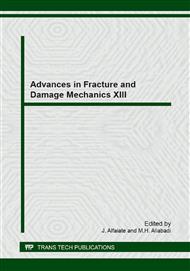p.153
p.157
p.161
p.165
p.169
p.173
p.177
p.181
p.185
Influence of Annealing Process on Crystallinity of Glass Fiber Reinforced Easily Degradable PLA Composites
Abstract:
To solve the problem of large environmental burden caused by disposal of FRP (Fiber Reinforced Plastics), Poly Lactic Acid (PLA), which is plant-derived and biodegradable, has received a lot of attention as an environmentally friendly material for the matrix of FRP. However, since the decomposition rate is very slow as compared with other biodegradable resins, it is difficult to make a processing of a large amount of PLA in the natural environment. Therefore, a method to accelerate decomposition rate of PLA by blending hydrolysis accelerator to PLA has been developed. In this study, composite material, in which PLA is blended with hydrolysis accelerator and reinforced with glass fibers, was molded using high speed compression molding process, and its tensile strength and the effect of heat treatment and tensile strength on the crystallinity was clarified. In consequence, regardless of the existence of hydrolysis accelerator, crystallinity of glass fiber reinforced PLA composites was improved by the annealing process. Tensile strength of glass fiber reinforced PLA decreased by the annealing process. For glass fiber reinforced PLA which was blended with hydrolysis accelerator, however, annealing process did not affect their tensile strength.
Info:
Periodical:
Pages:
169-172
Citation:
Online since:
September 2014
Keywords:
Price:
Сopyright:
© 2015 Trans Tech Publications Ltd. All Rights Reserved
Share:
Citation:


